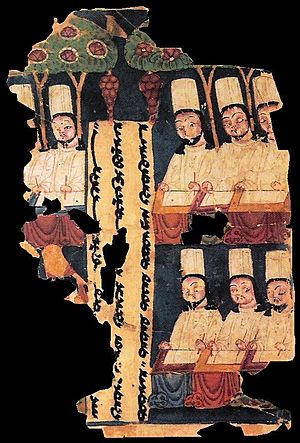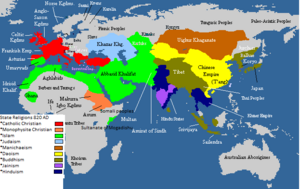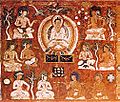Manichaeism facts for kids
Manichaeism (pronounced Man-i-KEE-ism) was an important religion that started in ancient Persia (modern-day Iran). It was founded by a prophet named Mani, who lived from about 210 to 276 AD. Manichaeism was a type of Gnosticism, which is a belief system that often focuses on special knowledge to reach salvation.
This religion became very popular between the 3rd and 7th centuries. At its peak, it was one of the most widespread religions in the world. Manichaean churches and holy books could be found as far east as China and as far west as the Roman Empire. The religion eventually faded away, disappearing in southern China before the 16th century.
The first six holy books of Manichaeism were written in a language called Syriac Aramaic. To help the religion spread, these books were quickly translated into many other languages. As Manichaeism moved east, its writings were translated into Middle Persian, Parthian, Sogdian, and later Uyghur and Chinese. When it spread west, the texts were translated into Greek, Coptic, and Latin. Other religions, like Christianity, Zoroastrianism, and later Islam, saw Manichaeism as a threat. Because of this, its followers were often treated badly and faced persecution.
Contents
What Did Manichaeans Believe?
Manichaeism taught that the world was a battleground between two powerful forces: light (good) and darkness (evil). They believed that human souls were part of the light, but they were trapped in the dark world of the body.
Mani taught that people could free their souls by following certain rules. These rules included living a very strict life, avoiding certain foods, and focusing on spiritual knowledge. Manichaeans believed that prophets like Zoroaster, Buddha, and Jesus had prepared the way for Mani, who they saw as the final prophet.
How Did Manichaeism Spread?
Manichaeism spread quickly because of its clear message and its organized church structure. Missionaries traveled far and wide, sharing Mani's teachings. They often translated their holy books into local languages, making the religion easier for new followers to understand.
The Silk Road, a network of trade routes connecting the East and West, played a big role in its spread. Merchants and travelers carried Manichaean ideas and texts across Asia and into Europe.
Why Was Manichaeism Persecuted?
Manichaeism faced strong opposition from other major religions. In the Roman Empire, Christians saw Manichaeism as a rival and a heresy. Famous figures like Augustine of Hippo were once Manichaeans before becoming Christian, and they later wrote against the religion.
In Persia, the Zoroastrian religion was the official state religion. Zoroastrians saw Manichaeism as a threat to their beliefs and power. Later, after the rise of Islam, Manichaeans also faced persecution in Islamic lands. These persecutions often involved destroying Manichaean books and punishing their followers.
Where Did Manichaeism Survive Longest?
Despite the persecution, Manichaeism managed to survive for centuries in some areas. It found a strong foothold in Central Asia, especially among the Uyghur people. The Uyghur Khaganate (an ancient kingdom) even made Manichaeism its official state religion for a time in the 8th century.
In China, Manichaeism continued to exist, often blending with local Buddhist and Taoist traditions to avoid persecution. Some Manichaean temples in China, like the Cao'an Temple in Jinjiang, still exist today, though they might appear more like Buddhist temples.
Images for kids
-
Yuan Chinese silk painting Mani's Birth.
-
Akshobhya in the Abhirati with the Cross of Light, a symbol of Manichaeism.
-
Augustine of Hippo was once a Manichaean.
-
Uyghur Manichaean clergymen, from a wall painting found in the Khocho ruins, 10th/11th century CE. It is now in the Museum für Asiatische Kunst, Humboldt Forum, Berlin.
-
Worship of the Tree of Life in the World of Light; a Manichaean picture from the Bezeklik Caves.
-
An image of the Buddha as one of the main prophets on a Manichaean pictorial roll fragment from Chotscho, 10th century.
See also
 In Spanish: Maniqueísmo para niños
In Spanish: Maniqueísmo para niños



















